
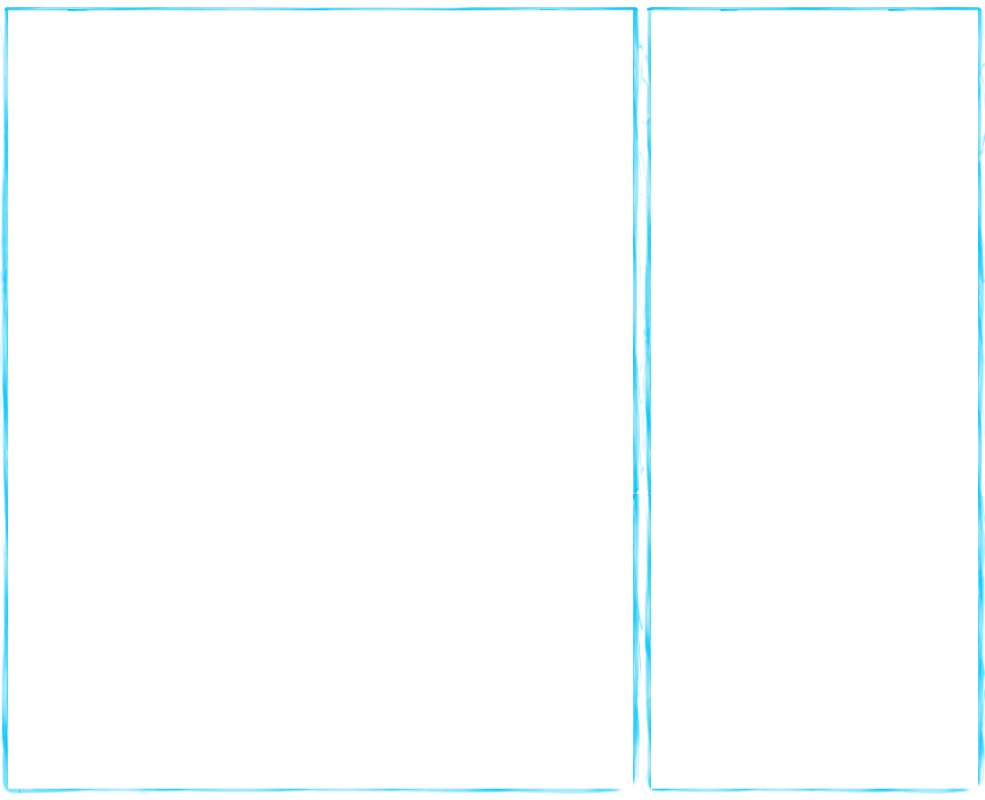
All Science Content
Similar Content
Waves Type
Wave Interference
Wave Parts
Wave Practice
Wave Property Game
Wave Travel Game
Waves Quiz
Waves Video
Vocabulary mouseover for definition
Wave Disturbance causing medium to vibrate.
Medium What a mechanical wave travels through
Vibrate Rapid back and forth motion
Transverse Wave Wave traveling perpendicular to the force
Longitudinal Wave Wave traveling parallel to the force
Surface Wave Also called a combination wave. Wave traveling in a circular motion, between 2 media
Crest Highest part of a transverse wave
Trough Lowest part of a transverse wave
Amplitude (transverse) distance from
resting place to crest/trough
(longitudinal) how compressed or rarefied
Resting Point Represents the medium before a disturbance (represented by a straight line in pictures)
Wavelength (transverse) from crest to crest
OR trough to trough
(longitudinal) from one compression to the next
Compressions The close together parts of a logitudinal wave (bunched up part)
Rarefactions The far apart parts of a logitudinal wave (spread out parts)
Frequency how often a complete wave passes a given point
Hertz unit to measure frequency, or how often a wave passes a given point (cycle per one second)
Reflection A type of wave interference described by a wave bouncing off of its medium.
Refraction A type of wave interference described by a wave bending as it goes through a medium
Diffraction A type of wave interference described by a wave bending around its meduim
Constructive Interference 2 waves interact resulting in a larger amplitude
Destructive Interference 2 waves interact resulting in a smaller amplitude
Similar Content
Waves Type
Wave Interference
Wave Parts
Wave Practice
Wave Property Game
Wave Travel Game
Waves Quiz
Waves Video
Vocabulary mouseover for definition
Wave Disturbance causing medium to vibrate.
Medium What a mechanical wave travels through
Vibrate Rapid back and forth motion
Transverse Wave Wave traveling perpendicular to the force
Longitudinal Wave Wave traveling parallel to the force
Surface Wave Also called a combination wave. Wave traveling in a circular motion, between 2 media
Crest Highest part of a transverse wave
Trough Lowest part of a transverse wave
Amplitude (transverse) distance from
resting place to crest/trough
(longitudinal) how compressed or rarefied
Resting Point Represents the medium before a disturbance (represented by a straight line in pictures)
Wavelength (transverse) from crest to crest
OR trough to trough
(longitudinal) from one compression to the next
Compressions The close together parts of a logitudinal wave (bunched up part)
Rarefactions The far apart parts of a logitudinal wave (spread out parts)
Frequency how often a complete wave passes a given point
Hertz unit to measure frequency, or how often a wave passes a given point (cycle per one second)
Reflection A type of wave interference described by a wave bouncing off of its medium.
Refraction A type of wave interference described by a wave bending as it goes through a medium
Diffraction A type of wave interference described by a wave bending around its meduim
Constructive Interference 2 waves interact resulting in a larger amplitude
Destructive Interference 2 waves interact resulting in a smaller amplitude
BEHAVIOR OF WAVES
IntroductionWe have learned that there are 2 types of waves: mechanical waves and electromagnetic waves. Mechanical waves need a medium (particles) in order to transfer the energy they are carrying. Electromagnetic waves do not need a medium (particles) in order to transfer the energy they are carrying.
Sooner or later the traveling wave, no matter what type it is, will come to the boundary of the medium it is traveling in. It may encounter another medium in which to enter. Not including empty space (vacuum), traveling waves will eventually display certain behaviors when they reach the boundary of the new medium:
*they will be reflected
*they will be refracted
*they will be diffracted
Reflection
 When a traveling wave hits a new medium in which it can not pass through, it is
reflected. The wave bounces off of the medium and travels in another direction. On flat surfaces waves don't bounce off in just any direction, they bounce off of the medium at the same angle that it bounced on it. The angle in which the wave hits the medium is called the
angle of incidence. The angle in which it bounces off is called the
angle of reflection. This behavior is called the
Law of Reflection. An irritating example of that would be when you pull out your mirror to reflect a light across the room into your friend's eye. It takes a little moving around, but you eventually find the right spot.
When a traveling wave hits a new medium in which it can not pass through, it is
reflected. The wave bounces off of the medium and travels in another direction. On flat surfaces waves don't bounce off in just any direction, they bounce off of the medium at the same angle that it bounced on it. The angle in which the wave hits the medium is called the
angle of incidence. The angle in which it bounces off is called the
angle of reflection. This behavior is called the
Law of Reflection. An irritating example of that would be when you pull out your mirror to reflect a light across the room into your friend's eye. It takes a little moving around, but you eventually find the right spot.
You could also test the Law of Reflection in a game of pool, where you have to maneuver the Cue ball around opponent balls to pocket the shot!
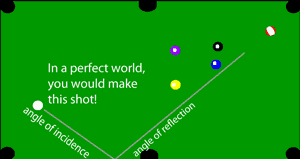
Refraction
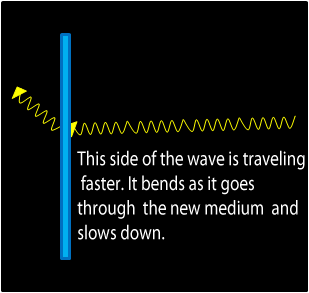 Sometimes a traveling wave hits a new medium and it does travel through it, but the new medium causes the wave to slow down or speed up as it enters. The change in the wave's speed will cause it to bend as it goes through. This behavior is called
refraction. It is like running on the beach. When you are running through the air, you are able to pick up some speed. But what happens when you run into the ocean? Your speed slows down because you entered a new medium- water.
Sometimes a traveling wave hits a new medium and it does travel through it, but the new medium causes the wave to slow down or speed up as it enters. The change in the wave's speed will cause it to bend as it goes through. This behavior is called
refraction. It is like running on the beach. When you are running through the air, you are able to pick up some speed. But what happens when you run into the ocean? Your speed slows down because you entered a new medium- water.
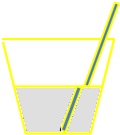 An everyday example of refraction would be how a pencil looks broken in a glass of water. The light waves traveling through the air in the glass travel faster than through the water causing a broken or fractured look.
An everyday example of refraction would be how a pencil looks broken in a glass of water. The light waves traveling through the air in the glass travel faster than through the water causing a broken or fractured look.
Diffraction
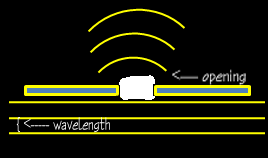
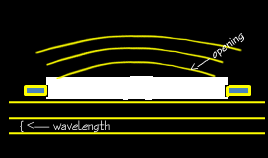 Diffraction is the bending of a wave as it travels around the boundary of an object (or between two objects).
Diffraction is the bending of a wave as it travels around the boundary of an object (or between two objects). The amount of bending depends on the size of the wavelength and the size of the opening it travels through.
If the size of the opening is close to the wavelength (represented by the distance between these lines), then you will see more bending. However, if the opening is a lot larger, you won't see as much bending.
Interference
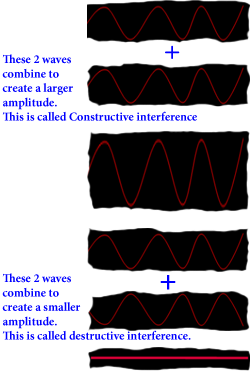 Waves are constantly running in to one another. When 2 waves meet, they create an interference. There are 2 types of interference:
constructive interference and
destructive interference.
Waves are constantly running in to one another. When 2 waves meet, they create an interference. There are 2 types of interference:
constructive interference and
destructive interference.If 2 waves meet and cause an increase
in amplitude, the it is called constructive
interference.
If 2 waves meet and cause a decrease
in amplitude, the it is called destructive
interference.